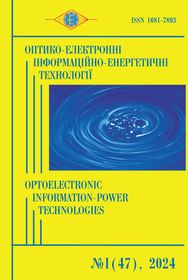Features of determining the location of the reference image on the current half-tone using the method of binary slices
DOI:
https://doi.org/10.31649/2413-4503-2024-17-1-78-87Keywords:
correlation processing;, halftone image;, reference image;, binary slice;, identification;Abstract
The possibility of creating new effective approaches and methods for the operation of visual systems of mobile works for the identification of tasks and objects of objects is due to the requirements of today. The work method is an analysis of the features of halftone image processing using the method of binary slices to identify a reference image in the field of the current image. The methods of analysis, abstraction and analogy were used as research methods. Separate articles offer an approach to complementing a reference halftone image on a current halftone image. To do this, we note the features of using the method of binary slices for processing a halftone image in combination with methods that allow you to destroy the reference binary image on the current binary image. The proposed approach includes a step of forming a set of binary slices of the halftone current image, a step of forming a set of binary slices of the halftone reference image, a step of matching the binary slices of the reference to the binary slices of the current image, a step of determining the location of each binary slice of the reference on the corresponding slice of the current image, and a step analysis of the obtained results and determination of the location of the halftone reference image on the halftone current image. A solution is proposed using a specific example. The practical value of the proposed approach is that a complex halftone image with a large number of brightness levels can be reduced to simple binary matrices, most of which are simply excluded from the processing process. At the same time, there remains a choice of the method of determining the binary slice of the standard on the field of the binary slice of the current image.
References
William K. Pratt, Digital image processing, 2nd Edition. A Wiley-Interscience publication, Wiley, 1991
Richard E. Woods, Rafael C. Gonzalez, Digital Image Processing, 4thEdition, Global Edition, New York, 2018
Shapiro, L. G. and Stockman, G. C. [2001]. Computer Vision. Prentice Hall, UpperSaddle River, NJ.
Snowden, R., Thompson, P, and Troscianko, T. [2012]. Basic Vision: An Introductionto Visual Perception. Oxford University Press, Oxford, UK.
Snyder, W. E. and Qi, Hairong [2004]. Machine Vision, Cambridge University Press, New York, https://doi.org/10.1017/CBO9781139168229, eBook ISBN 9781139168229
Kussul N. M., Shelestov A. Yu., ta Lavreniuk A. M., Intelektualni obchyslennia : navch. posibnyk. Kyiv, Ukraina : Naukova dumka, 2006. - 186 s.
Zbrutskyi O. V., Savenko Yu. M., ta Mishkin D. S., «Mobilni roboty: mozhlyvosti, perspektyvy, problemy», Mekhanika hiroskopichnykh system : naukovo-tekhnichnyi zbirnyk, Vyp. 26, s. 112–120. 2013. [Elektronnyi resurs]. Rezhym dostupu: https://ela.kpi.ua/handle/123456789/17292
John M. Holand, Designing Autonomous Mobile Robots: Inside The Mind of An Intelligent Machine, 2005. P. 113.
Nevliudov I. Sh., Andrusevych A. O., Yevsieiev V. V., Novoselov S. P., Demska N. P. Proektuvannia mobilnykh manipuliatsiinykh robotiv: Monohrafiia. – Kh. :, 2022. – 427 s.
Blaschke, Thomas. Object based image analysis for remote sensing. ISPRS journal of photogrammetry and remote sensing 65.1 (2010): 2-16.
Varfolomieiev A. Yu. Metody ta alhorytmy avtomatychnoho vidslidkovuvannia obiektiv na videoposlidovnostiakh. Kyiv, Ukraina : Vydavnytstvo «K i M», 2013. – 110 s.
Babaryka Anatolii. Study of detection and tracking algorithms of moving objects in video sequences from video surveillance cameras. Conceptual and scientifically-methodical principles of realization of policy in the field of the state border security in Ukraine: collective monograph. Lviv-Toruń: Liha-Pres, 2019. Vyp. Chapter 6. R. 89–105. DOI: https://doi.org/10.36059/978-966-397-184-1/89-105.
Zaichenko Yu. P. Osnovy proektuvannia intelektualnykh system. Kyiv. Ukraina. Slovo, 2004.
Muravskyi L.I. Obrobka binarnykh fazovykh zobrazhen v optychnykh i optyko-tsyfrovykh koreliatsiinykh systemakh. – Ternopil: serpen, 1999. – 187s.
T. B. Martyniuk, A. V. Kozhemiako, I. Yu. Vydmysh, ta D. O. Sharomov, Normalizovana koreliatsiina obrobka dvovymirnykh zobrazhen. Informatsiini tekhnolohii ta kompiuterna inzheneriia. №3(37). S. 44-50. 2016.
L. I. Tymchenko, Ya. H. Skoriukova, ta V. O. Tyshkivska, «Sehmentatsiia zobrazhen obiektiv za oznakamy zviazanosti dlia zadach tekhnichnoho zoru», Vymiriuvalna ta obchysliuvalna tekhnika v tekhnolohichnykh protsesakh, № 2. S. 70-72. 2004.
Ia. H. Skoriukova, A. L. Zhelezniak, L. I. Tymchenko, O. I. Stasiuk, ta S. M. Markov, Sehmentatsiia napivtonovykh zobrazhen. Monohrafiia, Kyiv, Ukraina: DETU, 2008.
Wójcik, W., Pavlov, S., Kalimoldayev, M. (2019). Information Technology in Medical Diagnostics II. London: Taylor & Francis Group, CRC Press, Balkema book. – 336 Pages, https://doi.org/10.1201/ 9780429057618. eBook ISBN 9780429057618.
Downloads
-
pdf (Українська)
Downloads: 84
Published
How to Cite
Issue
Section
License
Автори, які публікуються у цьому журналі, погоджуються з наступними умовами:- Автори залишають за собою право на авторство своєї роботи та передають журналу право першої публікації цієї роботи на умовах ліцензії Creative Commons Attribution License, котра дозволяє іншим особам вільно розповсюджувати опубліковану роботу з обов'язковим посиланням на авторів оригінальної роботи та першу публікацію роботи у цьому журналі.
- Автори мають право укладати самостійні додаткові угоди щодо неексклюзивного розповсюдження роботи у тому вигляді, в якому вона була опублікована цим журналом (наприклад, розміщувати роботу в електронному сховищі установи або публікувати у складі монографії), за умови збереження посилання на першу публікацію роботи у цьому журналі.
- Політика журналу дозволяє і заохочує розміщення авторами в мережі Інтернет (наприклад, у сховищах установ або на особистих веб-сайтах) рукопису роботи, як до подання цього рукопису до редакції, так і під час його редакційного опрацювання, оскільки це сприяє виникненню продуктивної наукової дискусії та позитивно позначається на оперативності та динаміці цитування опублікованої роботи (див. The Effect of Open Access).


